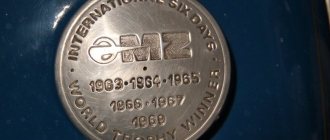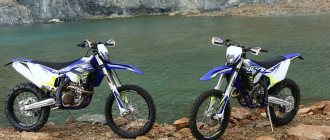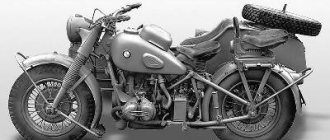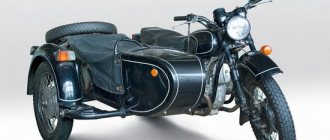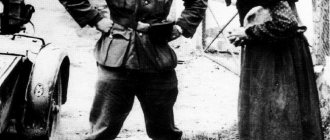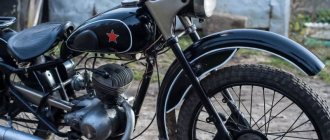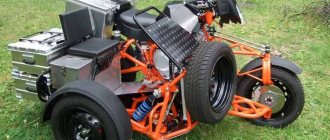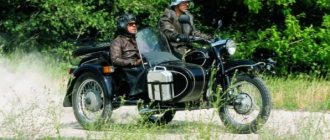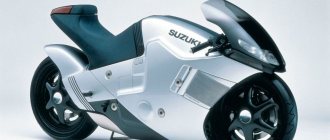Izh is a Soviet and Russian brand of motorcycles developed and produced from 1929 to 2008 in the city of Izhevsk.
In 1928, drawings were created at Izhstalzavod under the leadership of engineer P.V. Mozharov, and in 1929 samples of the first Izhas were made. Attempts to create the first prototypes of Russian motorcycles were made in 1914-1918 by the Moscow and Riga Leitner factories, but they were not crowned with success. We can consider three periods in the history of motorcycle manufacturing: prototype production, serial production, and mass production.
Production of prototypes
Production of prototype motorcycles (Izh-1, Izh-2, Izh-3, Izh-4, Izh-5) in the Motosection workshops at the Izhevsk arms factory in the period 1928-1929.
In a matter of months, five motorcycles of five different models were developed, manufactured and prepared for participation in the All-Union Motorcycle Rally. The most impressive motorcycles were the colossi Izh-1 and Izh-2 with two-cylinder V-shaped engines with a displacement of 1200 cm³ and a maximum power of 24 hp. For their time, these were extremely original and advanced designs. The engine crankshaft was located longitudinally, torque was transmitted to the rear wheel from a three-speed gearbox, mounted in a block with the engine, and a driveshaft. The massive stamped frame and front fork, which combined the properties of parallelogram and lever, were inspired by the ideas of designer Ernst Neumann-Neander, whom Mozharov met during an internship in Germany. The lower part of the frame also served as a muffler housing - this feature was characteristic of all five motorcycles of the first series. "Izh-2" was distinguished by a fan for cooling the engine and a drive to the sidecar wheel. Izh-3 had a two-cylinder V-shaped 750 cc Wanderer engine, the crankshaft of which was located transversely, and drive to the rear wheel by a chain operating in a hermetically sealed casing filled with oil.
Izh-4 is one of the lightest of the five, distinguished by a single-cylinder two-stroke Shtok engine and rear-wheel drive by a shaft.
"Izh-5", nicknamed "Composition", was created using units of the 500 cc Neander motorcycle, but with the original front fork and a modified frame.
All these motorcycles took part in the Second All-Russian Motorcycle Ride, held in September-October 1929, and successfully covered 3,300 km - not only the race route, but also the distance from Izhevsk to Moscow. After the end of the run, the smallest of the experimental models, Izh-4, was recommended for mass production. However, Izhstalzavod received a more important order, and the first experience of motorcycle production was not continued. But Mozharov did not stop there and moved with his group to Leningrad, where he began developing the light motorcycle “L-300” according to documentation brought from the German company DKW.
Motorcycle engines IZH
All production motorcycles had two-stroke engines, which forced owners to fill the gas tank not with pure gasoline, but mixed with oil. Prototypes with 4-stroke engines were never put into mass production, and sports motorcycles, produced in limited editions, do not count here.
In general, IZH engines are considered unpretentious, but due to their outdated design, their service life is short, especially in the first generations. But thanks to the simplicity of the engines, even a beginner can repair them, which is why in rural areas and remote regions IZHs are still in demand, despite the fact that they are gradually being replaced by Chinese motorcycle manufacturers.
Mass production
Serial production at the motor plant (Izh-7, Izh-8, Izh-9, Izh-12) in the period 1933-1941.
By the early 1930s, motorcycles were not being manufactured. Despite this, separate initiative groups of enthusiasts in Moscow, Leningrad, Kharkov, including P.V. Mozharov in Izhevsk, worked on the creation of a domestic motorcycle. A commission of experts of the Presidium of the Supreme Economic Council of the USSR considered the issue of building a large motorcycle plant and came to the conclusion that the most suitable place for its location would be Izhevsk. The city had a full range of engineering production - from steel smelting to the manufacture of complex tools and machine tools, the workers had the necessary qualifications, and there were no difficulties in the supply of raw materials. Here, on the basis of the hunting rifle factory of the manufacturer Berezin, located on Bazarnaya Street, the construction of the Experimental Motorcycle Plant began.
At first, they planned to produce the heavy motorcycle “NATI-A-750” at this plant, designed under the leadership of P.V. Mozharov. The motorcycle had a two-cylinder V-shaped engine with a displacement of 747 cubic cm, a stamped frame characteristic of Mozharov motorcycles, and reached a power of 15 hp. By May 1, 1933, the first 4 motorcycles were manufactured. At the same time, prototypes of the Izh-7 light motorcycles were assembled according to documentation received from Leningrad. In fact, these were twins of the L-300 model (the same copy of the DKV-Luxus-300 developed by Mozharov) - a two-stroke single-cylinder engine with transverse blowing, a three-speed gearbox, a chain drive to the rear wheel, a frame made of stamped elements assembled on bolts, parallelogram front fork, unsprung rear wheel. But the Izh-7 underwent the sadly familiar operation of “reducing labor intensity”: the trunk and front flaps disappeared, the flat footboards were replaced with round ones, the rotating throttle handle was replaced by a rotary shifter, the decompressor drive was not remote, but by a tap on the cylinder head.
In the end, it was the Izh-7 that was chosen for serial production. True, of the 12 motorcycles manufactured in 1933, almost all returned to the factory - the ignition system failed. But soon the “childhood illnesses” were overcome, and in 1934 the plant produced 111 motorcycles.
At the beginning of 1938, the Izh-7 was replaced by a new model, the Izh-8. The 300 cc engine received a loop scavenging with two scavenging channels, due to which the power increased from 5.5 to 8 hp. The electrical system has also become more advanced - instead of a flywheel magneto, the car is now equipped with a generator and a battery. And in 1940, production of the Izh-9 model began, with its capacity increased to 9 liters. With. power. At the same time, documentation was received from Leningrad for the L-8 motorcycle, equipped with a 4-stroke overhead valve engine with a displacement of 348 cm³ and a maximum power of 13.5 hp. To speed up the development of the new model, it was decided to use the chassis of the Izh-9 motorcycle. Serial production of the new motorcycle, designated “Izh-12,” was supposed to begin in the summer of 1941. However, the further development of motorcycle manufacturing at the plant was prevented by the war.
Motorcycles "Java"
Another legendary Jawa motorcycle dates back to 1929. This brand of road transport belonged to a Czechoslovak company and was the dream of many Soviet motorcycle enthusiasts. Motorcycles were used not only for everyday travel, but also participated in various racing competitions. In the 21st century, the production of Java has not stopped; some models are still in demand.
Jawa 350 Classic
This is an affordable road bike for the price of a budget used car. The Jawa 350 Classic 638 gained particular popularity in the 90s, but even now it is still in demand among buyers and is actively produced. The motorcycle has not lost its external individuality, which makes it recognizable on the roads.
The motorcycle is based on a 2-cylinder, 2-stroke system with a 4-speed gearbox. There is no connection between gasoline and oil thanks to a separate lubrication system. The motorcycle frame is strong, which allows you to load motor vehicles up to 200 kg. It is possible to attach a car seat.
If we compare the Jawa 350 Classic 638 model with others, more expensive and equipped, it wins in several respects: maintenance is simple and inexpensive, fuel consumption is low, spare parts are available for sale at a low price.
Technical characteristics of "Java" 350 classic:
- dimensions – 2110×750×1070;
- engine capacity - 343.5 cubic meters. cm;
- power – 23.1 l. With.;
- maximum speed – 125 km/h;
- gasoline consumption per 100 km – 4 liters;
- manual gearbox.
The cost of a new motorcycle produced in 2021 varies from 500,000 to 540,000 rubles.
Jawa 350 Classic Sport
“Classic Sport” is an improved version of Jаwa 350 Classic. It was presented in 2015 at the Moscow exhibition “Motopark”. You can distinguish the model from other Java motorcycles by the “outdated” design of London in the 60s, when street motorcycle racers converted inconvenient and bulky motorcycles for themselves, removing everything unnecessary. The two-wheeled vehicle turned out to be light and maneuverable, with streamlined elements.
Jawa 350 Classic Sport is designed for solo travel and is equipped with one comfortable seat. The low steering wheel allows you to comfortably take the position of the rider, fully concentrating on the ride. The “rarity” of the motorcycle is reminiscent of its classic elements: a wide chrome exhaust pipe, a round headlight and a traditional red body color.
The motorcycle has a lot of advantages that make for a comfortable and maneuverable ride: a 343 cc engine, a separate lubrication system, a reliable disc-type brake system, a laconic dashboard and an automatic starter.
Specifications:
- engine capacity – 343.5 cubic meters;
- number of cylinders – 2;
- number of cycles – 2;
- power – 23 l. With.;
- maximum acceleration speed – 125 km/h;
- gasoline consumption per 100 km – 4 liters;
- air cooling system.
This model began to be produced in 2015, but it is no longer produced. Jawa 350 Classic Sport will cost the buyer 210-350 thousand rubles.
Jawa 350 Lux
The presented model is a classic version of a street class road motorcycle. It combines elements of older models, but also has individual modern features. The front of the motorcycle has a classic single headlight, and the electronic instrument panel is simple and understandable even for novice motorcyclists.
The basis of the two-wheeled design is a strong steel alloy frame. Its rigidity improves maneuverability on uneven roads, makes the vehicle maneuverable and increases load capacity. The holistic appearance of the Java 350 Lux clearly resembles a “classic”.
Specifications:
- dimensions – 2110×750×1070 mm;
- engine capacity – 343 cubic meters. cm;
- number of cycles – 2;
- number of cylinders – 2;
- power – 23.1 l. With.;
- maximum speed – 125 km/h;
- Fuel consumption per 100 km is 4 liters.
Those wishing to purchase the Jawa 350 Lux motorcycle model will need to pay about 300-340 thousand rubles for it.
Jawa 660 Sportard
The most powerful Java model in terms of technical equipment is the 660 Sportard. The engine capacity of 600 cubic meters affects the ability to reach speeds of up to 250 km/h. The motorcycle covers distances along the highway easily and maneuverably. For beginner motorbikers, this is an excellent tool - flexible and playful. And externally, the 660 Sportard looks more aggressive and modern than the classic versions.
The technical characteristics have their own characteristics: the power plant is “single-barrel”, equipped with an electronic injection system - EFI. The frame frame has a high degree of rigidity, and this is an important condition for off-road driving - the motorcycle does not twitch and is easy to control. The upgraded suspension of the bike allows you to take turns at the same speed without pressing the brake pedal.
The technical specifications are as follows:
- dimensions – 2100×760×1250 mm;
- cylinders – 1;
- number of measures – 4;
- engine capacity – 651.9 cubic meters. cm;
- power – 48 l. With.;
- gas tank volume – 17 liters;
- Manual transmission – 5-speed.
The cost of the new 2021 model varies between 800-870 thousand rubles, depending on the equipment.
Mass production
Mass production has been carried out at the Izhevsk Machine-Building Plant (currently OJSC Izhmash and DOJSC Izhmash-Moto) from 1946 to the present day, during which about 11 million motorcycles of various models have been produced. This information is not entirely reliable, since the plant went bankrupt in 2008.
In 1946, the plant received equipment, drawings and technologies exported from Germany as part of reparations, and began production of the Izh-350 motorcycle - making a copy of the German DKW NZ-350. It was a mixture of varieties of the German motorcycle. So, the crankcase was made of aluminum alloy, like the early models, but the mud flaps were like the later ones, produced already during the war. The motorcycle was adapted for domestic electrical equipment and instruments. In general, the general appearance and design were almost identical to the German original. It should be noted that for its time it was a fairly modern, simple and reliable motorcycle. It was decided to put the production of the motorcycle at the weapons factory.
A characteristic feature of the Soviet motorcycle industry in the 40-60s was the production of sports modifications of road motorcycles. Having laid the foundation for the development of mass motorsports, they at the same time became “test benches” for testing those solutions that were then applied to serial products. In 1948, the Izh-350S motorcycle was manufactured in Izhevsk with a telescopic front fork, replacing the archaic parallelogram one. The rear wheel received a spark plug suspension with spring-hydraulic shock absorbers. The engine had an aluminum cylinder with a cast iron liner. Its power increased to 14 hp. In 1950, mass production of an improved version of the Izh-50 sports motorcycle began.
In 1951, in a short time, designers created a more advanced model, the Izh-49. Due to the use of a telescopic front fork, a rear suspension with hydraulic shock absorbers and other improvements, ride comfort and operational reliability have increased, and the motorcycle's cross-country ability in poor road conditions has improved. Without stopping production, a transition was made to the mass production of Izh-49 motorcycles, which gained universal popularity among the population of our country and opened the way to foreign markets. This was the first model of Izhevsk motorcycles with a side trailer, the production of which was organized in Vyatskie Polyany. Subsequently, a pilot batch of cars with sidecars was produced.
In 1955, production began of a new family of sports motorcycles with a welded tubular frame and swing-arm rear suspension. The Izh-54 for road racing had an 18 hp engine, and the Izh-55 for cross-country and multi-day competitions had a 16 hp engine.
The design group working on the design of motorcycles was allocated to a special bureau. In 1956, a new model appeared - “Izh-56”, and soon the plant already produced a pilot batch of them. The design of the motorcycle was significantly different from those previously produced. The stamped frame became tubular, deep wheel guards were provided to protect the driver from dust and dirt, and a sponge rubber saddle with a cover was provided. The carburetor and air cleaner were covered with covers, which, in combination with the tool boxes, gave the car a good appearance. Wheels with straight spokes became interchangeable. It was 20 percent more powerful than its predecessor, with engine power increasing to 13 hp. It is not surprising that the Izh-56 has become a more popular model. Its “circulation” during production amounted to 680 thousand units, of which 130 thousand were equipped with a side trailer. Overall the car has become more modern.
Subsequently, in collaboration with employees of the central design experimental bureau, a number of prototypes of motorcycles and individual components are created and tested. The advanced design group designs the Saturn, Orion, and Sirius motorcycles. The most original of them was the Saturn - a 250 cm³ class car. Unlike a regular motorcycle with a welded frame, this was a frameless model. The gas tank, steering column and tool boxes were a single unit, in the lower part of which the engine was suspended. At the same time, several modifications of sports cars were created. On the basis of the first road motorcycles "Izh-350" and "Izh-49" sports cars "Izh-350S", "Izh-50", "Izh-50A", "Izh-50B" appeared, on which our athletes begin to take part in motorcycle competitions and successfully defend the honor of the Izh brand.
In 1954-1955, the Izh-54 and Izh-54A motorcycle models were developed for road racing. Their engines developed power up to 20 hp. Competing on these machines, our athletes, including Master of Sports V. Medvedev, won the title of USSR champion and took prizes. Around the same period, the Izh-55M and Izh-55K motorcycles were created for multi-day and cross-country competitions. In the future, they are replaced by more reliable models “Izh-57M” and “Izh-57K”.
In the second half of 1958, the designers of the bureau faced a new task - preparing for the release of the Izh Jupiter motorcycle. Izhevsk machine builders demonstrated a prototype of the new model at the World Exhibition in Brussels already in 1957. The motorcycle was first called “IZH-58”, and then renamed “Izh Jupiter”. The motorcycle retained the crew part of the Izh-56, but had a completely new two-cylinder engine. The first prototypes showed very good results. The engine power was increased to 18-19 hp, the engine had an original design of separate cylinders. The gearbox was also more convenient to use. Improved bearing lubrication. Engine production was organized at the Izhevsk Mechanical Plant. Serial production began in 1961. The motorcycle was produced in two modifications - both for riding alone and with a side trailer.
Since 1962, on the basis of the Izh-56 machine, the production of the Izh Planet motorcycle was mastered. The crew of this model was maximally unified with the Izh-Jupiter. The warranty mileage of the Izh-Planet compared to the Izh-56 has increased by 2000 km, and the service life of the cylinder and piston group parts has been increased by one and a half times thanks to the use of a contact-oil air cleaner.
The period 1966-1970 for motorcycle manufacturers was marked by the development of new road motorcycles “Izh Planeta-2” and “Izh Jupiter-2”.
The years 1971-75 were devoted to the production of road motorcycles “Izh Planeta-3”, “Izh Jupiter-3”, “Izh-Jupiter-3K”, “Izh Planet Sport”. The listed brands of motorcycles combine reliability in operation and ease of maintenance. With the acquisition of experience in developing structures, equipping production with new progressive equipment, and the emergence of new materials, the development period of new models has shortened, the volume of their production has increased, and performance characteristics have improved. An example is Izh Jupiter-3, whose power has increased by almost 40 percent compared to its predecessor. The Izh Planeta-3 and Izh Jupiter-3 models were awarded the State Quality Mark. Their production was increased in 1975 to 250 thousand per year.
The Izh Planet Sport motorcycle, developed in 1973, stands apart. This is a completely new model, which was different from the German one. In the first years, the motorcycle had imported components. The engine, combined with a Japanese Mikuni carburetor, developed a power of 32 hp, and a new separate lubrication system was used here for the first time. This model was very popular among young people. Subsequently, the plant abandoned imports and began to replace components with domestic ones, which led to a change in the appearance of the motorcycle for the worse; the engine began to develop only 28 hp, and reliability dropped. The IZH-PS 01 model was being prepared for production with the unification of some components with road models, but it was decided to completely discontinue this legendary model
In the early 80s, construction of a new motorcycle production complex was completed. Highly automated, equipped with overhead assembly conveyors, it was designed to produce 450 thousand motorcycles per year. In 1981, production of Izh Jupiter-4 motorcycles began in the new complex. And in 1982, Izh Planeta-4 appeared with new 12-volt electrical equipment.
Since 1985, production of the Izh Jupiter-5 motorcycle began with an engine whose power was reduced from 28 to 24 hp. An “emergency start” button appeared, which turned off all devices except the ignition when starting with a low battery. Izh Planeta-5, released in 1987, received a significantly updated engine with a power of 22 hp. and a new appearance: gas tank, trim and instrument panel. Soon “Jupiter” changed in a similar way. During the same period, based on the Japanese XT-550 engine, prototypes of the Orion, Marathon and Sprinter motorcycles, which are still promising to this day, were designed and manufactured. In terms of their design and characteristics, these were very modern and bold models.
Over the entire period of Izhi production, the color range was not large, so the frame was painted in a classic black color; the rest was dominated by blue, red, and light brown.
In the period 1992-96, the Izh 9.204 cargo side trailer and the Izh 9.604 GR cargo module were developed. The design of the cargo module was developed in such a way that it can be installed on any motorcycle of the Planet or Jupiter families. By installing a cargo module instead of the rear wheel and pendulum fork of a motorcycle, you get a three-wheeled cargo motorcycle with a symmetrical arrangement of wheels. The presence of a transfer case, differential lock, and reverse gear expands the scope of use of the motorcycle.
From 1995 to 1998, a range of stationary engines was developed: SD 101 - based on the Izh-PS engines and SD 1012 - based on the Izh-P-5 engine. Simultaneously with the development of the Izh NTS centrifugal self-priming pump, the Izh MP-1 motor pump with an SD 1012 engine was designed.
1997 was marked by the development of the Izh 6.92001 motorcycle for transporting fire-fighting equipment (motor pump, set of fire hoses, fire extinguisher, etc.) and the Izh 6.920GR cargo motorcycle with the Izh-Yu-5 Sb.1-08.10 liquid engine cooling, developed at the Izhevsk Mechanical Plant in 1990-92.
In the period 1996-2000, a fundamentally new model appeared - the Izh 6.113-05 motorcycle (aka "Junker") in the chopper style.
The Moscow traffic police platoon, in order to support the domestic manufacturer, used Izh-Junker models as an experiment for several years. For various reasons, in the future, the management of the Moscow traffic police refused to continue purchasing Izh motorcycles.
Due to large debts, the IZhmoto plant was mothballed in 2008 for an indefinite period, and most of the equipment was sold off.
Motorcycles IZH
60 different models were produced under this recognizable name . Perhaps production will even be resumed, since special equipment for the Cortege project, intended to accompany the president, will be produced under the IZH brand.
Prototypes
There were very, very many of them. An example would be Planets 5 and 6, which did not progress beyond the prototype stage. They were already developed in Russia, in the 90s, but mass production was never launched.
This category also includes unique bikes produced in limited editions for participation in competitions. IZH-M12 existed in only 10 copies, and IZH-M10 was produced in the amount of 18 pieces. At the same time, most of the sports prototypes were created on the basis of the company’s road bikes, albeit redesigned from top to bottom. The last of them, M16, was quickly forgotten, but it could have been a worthy competitor for many European models.
Road motorcycles
“Planet” and “Jupiter” - who doesn’t know these two series? They were classic road motorcycles, durable and versatile, perfect for roads without hard surfaces, which were sufficient in the vast expanses of the USSR. There were sometimes a lot of problems with them, but many Soviet motorcycle tourists traveled on these bikes throughout the country without experiencing any problems. A special advantage was that almost any IZh road motorcycle of these series could be equipped with a side trailer, that is, a sidecar, which significantly increased its suitability for tourism.
Special motorcycles
In addition to the above-mentioned versions of Juncker and Jupiter-5 for the needs of the traffic police, the company was also noted for the release of some other notable examples of equipment. For example, IZh Samson is a full-fledged all-terrain vehicle, or model 6.92001, designed specifically for firefighting in rural areas. In the Russian open spaces you can also find IZH GR, a cargo modification with a body for transporting anything. And we cannot fail to mention Planet Sport again, which, strictly speaking, belongs to the line of the same name. The only pity is that there have been no new copies for a long time, and, alas, there are no signs in sight.
Motorcycles "Minsk"
Motorcycles of the Belarusian brand "Minsk" began to be produced in 1951, and in 2007 the manufacturing plant became private from a state-owned one.
Minsk D4 125
This model is simple and economical, but at the same time fully adapted to the roads of Russia and the CIS countries. The modern design fits perfectly into the traffic flow of the vehicle. The motorcycle is light and maneuverable, with good and smooth shock absorption.
The vehicle has a 125 cc engine. cm and a capacity of 10.2 liters. With. The built-in electric starter responds instantly to starting. The external design is individual. Dimensions – 2100x1110x770 mm.
Cost from 43 to 60 thousand rubles. Available in three colors - red, blue and black.
Minsk S4 125
Minsk C4 125 was released in 2008. Light in both weight and control, maneuverable, inexpensive - this transport is chosen by young people and summer residents. It makes a good first bike for new riders, although its understated appearance may put some off at first glance.
The C4 125 model has a number of advantages:
- low cost;
- low fuel consumption;
- small dimensions and weight;
- adaptation to temperature changes.
There are also disadvantages:
- fastenings are unreliable;
- small mirrors contribute to poor visibility;
- The included tool kit does not fit the motorcycle;
- the electric engine start button is located at an inconvenient level;
- small fairing.
The cost of a motorcycle Minsk C4 125 is 65,000 rubles. Available in blue, yellow and red.
Minsk TRX 300i (tour-enduro)
The Minsk TRX 300i, which is more modern in design, attracts attention with its bright and sporty appearance. It embodies the qualities of enduro from European manufacturers, which significantly distinguishes it from its Belarusian compatriots. This motorcycle is designed for long trips on a variety of road surfaces.
The 4-stroke engine is started using an electric starter. Movement is carried out by a 6-speed manual transmission. The transport is designed to transport 2 people.
Characteristics:
- dimensions – 2080/825/1230 mm;
- weight – 155 kg;
- front suspension – telescopic fork;
- rear suspension - mono shock absorber.
You can purchase this model at a price of 315,000 rubles. The motorcycle is available in the following colors: orange, blue, yellow, red, white and green.
MINSK RX 250 (cross)
The cross-country “Belarus” is the latest development of the Minsk manufacturer. A special feature of the motorcycle is that it is assembled from parts from leading companies:
- Domino controls;
- Acerbis plastic;
- Leo Vince muffler;
- Dell'Orto carburetor;
- professional Fast Ace suspension;
- DID circuit
The wheels are equipped with aluminum rims with spokes made of durable metal alloys. The RX 250's exterior is bold and sporty. The model attracted the interest of avid crossers, so in the 2011-2012 season the motorcycle took part in the “Belarusian Motocross Championship” and proved itself to be a reliable and serious racer.
The cost of the motorcycle is 168,000 rubles.
